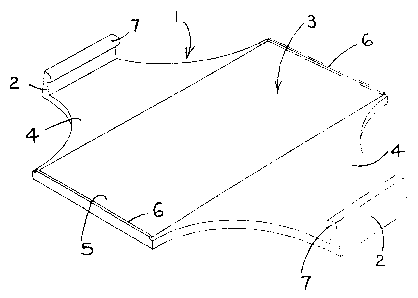Some of the information on this Web page has been provided by external sources. The Government of Canada is not responsible for the accuracy, reliability or currency of the information supplied by external sources. Users wishing to rely upon this information should consult directly with the source of the information. Content provided by external sources is not subject to official languages, privacy and accessibility requirements.
Any discrepancies in the text and image of the Claims and Abstract are due to differing posting times. Text of the Claims and Abstract are posted:
| (12) Patent Application: | (11) CA 2415898 |
|---|---|
| (54) English Title: | CASE-HOLDERS |
| (54) French Title: | PORTE-BOITIERS |
| Status: | Deemed Abandoned and Beyond the Period of Reinstatement - Pending Response to Notice of Disregarded Communication |
| (51) International Patent Classification (IPC): |
|
|---|---|
| (72) Inventors : |
|
| (73) Owners : |
|
| (71) Applicants : |
|
| (74) Agent: | SMART & BIGGAR LP |
| (74) Associate agent: | |
| (45) Issued: | |
| (22) Filed Date: | 2003-01-02 |
| (41) Open to Public Inspection: | 2004-07-02 |
| Availability of licence: | N/A |
| Dedicated to the Public: | N/A |
| (25) Language of filing: | English |
| Patent Cooperation Treaty (PCT): | No |
|---|
| (30) Application Priority Data: | None |
|---|
A holder for displaying a CD or DVD case (10) has a bowed
configuration with regions (4) sloping up to a central,
flat region (5) between a pair of opposed, hooked lugs
(2). The back-face (11) of the case (10) rests on the
region (5) between upturned lips (6) and the lugs (2)
bear resiliently on opposite edges (13,14) of the case
(10) to retain it firmly. Rocking of the case (10) frees
the projecting rim (16) of the edge (13) from the hook-
end (7) of the abutting lug (2). Alternative holders
have a central spine (22;45) with laterally-extending
legs (23,25;41,43) that terminate in hooked-lugs (24;42)
or plain lugs (26;44), and have a wave-contour for back-
support of the case (30).
Note: Claims are shown in the official language in which they were submitted.
Note: Descriptions are shown in the official language in which they were submitted.

2024-08-01:As part of the Next Generation Patents (NGP) transition, the Canadian Patents Database (CPD) now contains a more detailed Event History, which replicates the Event Log of our new back-office solution.
Please note that "Inactive:" events refers to events no longer in use in our new back-office solution.
For a clearer understanding of the status of the application/patent presented on this page, the site Disclaimer , as well as the definitions for Patent , Event History , Maintenance Fee and Payment History should be consulted.
| Description | Date |
|---|---|
| Inactive: IPC from MCD | 2006-03-12 |
| Inactive: IPC from MCD | 2006-03-12 |
| Application Not Reinstated by Deadline | 2006-01-03 |
| Time Limit for Reversal Expired | 2006-01-03 |
| Deemed Abandoned - Failure to Respond to Maintenance Fee Notice | 2005-01-04 |
| Application Published (Open to Public Inspection) | 2004-07-02 |
| Inactive: Cover page published | 2004-07-01 |
| Inactive: First IPC assigned | 2003-03-13 |
| Inactive: IPC assigned | 2003-03-12 |
| Application Received - Regular National | 2003-02-14 |
| Inactive: Filing certificate - No RFE (English) | 2003-02-14 |
| Correct Applicant Requirements Determined Compliant | 2003-02-14 |
| Correct Applicant Requirements Determined Compliant | 2003-02-14 |
| Abandonment Date | Reason | Reinstatement Date |
|---|---|---|
| 2005-01-04 |
| Fee Type | Anniversary Year | Due Date | Paid Date |
|---|---|---|---|
| Application fee - standard | 2003-01-02 |
Note: Records showing the ownership history in alphabetical order.
| Current Owners on Record |
|---|
| MATTHEW EDWARD THOMAS WHITE |
| Past Owners on Record |
|---|
| None |